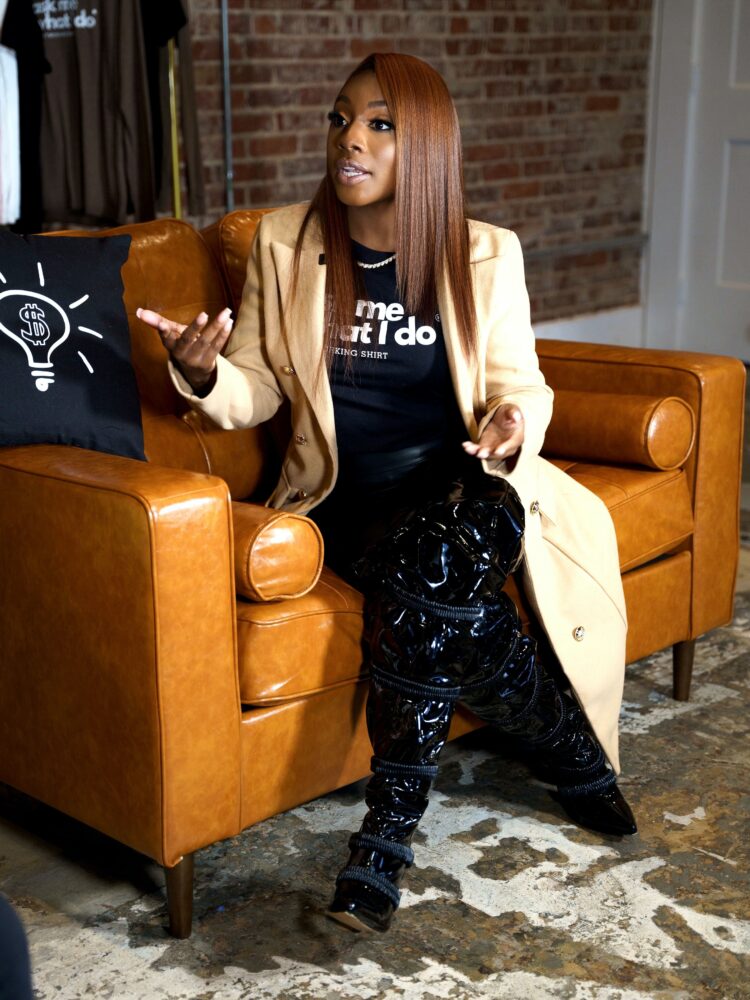If you’re a female in the workplace, are you speaking in a way that undermines your authority?
Historically, powerful women have been given derogatory labels (and worse) for standing out. While things have improved since then, women are still up against considerable obstacles in the workplace – and some of them come down to how they’ve been conditioned to communicate.
Is how you were conditioned to speak working for or against you?
If you aim to assert yourself as a leader and become an authority, you may not be aware of it, but how you’ve been conditioned to communicate could sabotage your efforts.
From a young age, girls are taught to:
- Speak softly
- Be diplomatic
- Keep the peace

Photo by ThisisEngineering RAEng on Unsplash
Because of this, women tend to learn a different communication pattern than men – and that can reverberate throughout their careers by making people take them less seriously than their male counterparts.
The worst part is – you might be speaking in a way that destroys your credibility without even knowing it. Or, it’s possible to do the opposite: to overcompensate because of a fear of not being taken seriously in the workplace.
Either of these approaches can be counterintuitive.
Here is a guide on how women can communicate clearly, confidently and assertively so that they show up as the authority that they are. In this article, you’ll learn:
- The differences between how men and women communicate.
- Whether the way that you communicate is damaging, as a female.
- How to make make your communication style more impactful and influential.
Table of Contents
1. Stop blaming yourself first
The facts:
If something goes wrong at work, women tend to point the finger at themselves.
In her TEDx talk, Reshma Sujani observed that men are likely to talk about workplace problems by saying:
“There’s something wrong with my project.”
However, women tend to say:
“There’s something wrong with ME.”

Photo by SHVETS production
Why it’s a problem:
The way that a woman communicates about failure is problematic.
When men focus on the project as the issue, instead of themselves, not only are they asserting that they are not to blame but also their agency in correcting the problem.
However, correcting the problem is harder if it’s yourself.
This is a sign that women are assigning the failure of the project to themselves, to the failure of their own capabilities.
The solution:
Be mindful of the way you communicate failure. If you find yourself using language that says “you” are the problem, rephrase it intentionally to indicate that the problem is external, and your capability lies in detecting it and solving it.
Pro-tip:
The truth is – you may not be the problem at all. The issue may lie elsewhere – but if you’re female, you may be quick to blame yourself for it. Brené Brown talks about blame and says, “I’d rather it be my fault than no one’s fault… why? ‘Cause it gives us some semblance of control”.
The best way to deal with a problem is to take a good, hard look at it rather than assigning blame (to yourself or someone else) at the outset.
2. Be careful of the jokes you tell

Photo by RDNE Stock project
The facts:
Women tend to use more self-deprecating humor at work.
Why it’s a problem:
Here’s what you may want to know before you tell that self-deprecating joke: females who are apt to participate in self-deprecating humor are sometimes seen as less capable leaders. This can be especially true for those who aren’t leaders yet.
While humor is a great way to offset the seriousness of the workplace, excessive self-deprecating humor can serve to undermine women (and even men) who aren’t in leadership positions.
This is why many men primarily tend to use humor to make fun of a situation rather than poking fun at themselves.
The solution:
Keep being funny at work, but balance your self-deprecating humor with other types of humor.
3. Learn to share an idea without hedging

Photo by RDNE Stock project
The facts:
If you’re a female, the questions you’re asked in a meeting may already be working against you.
Antonella Cvrtak has noticed, “Male founders mostly get asked about the vision, the big dreams, the goal at the end of the journey…” whereas female founders “get asked more about the current situation, the worst cases… what happens if you don’t reach… that goal.”
This can make you feel less confident (and even defensive). You might start using hedging phrases like:
- “What about this idea?”
- “…if that makes sense.”
- “Perhaps/possibly/usually…”
Why it’s a problem:
Why do we use these words that make us sound unsure? Partly because we feel unsure, being put on the defensive by being questioned about our leadership, and partly because women are taught to be inclusive – which can be a huge strength. But if you use hedging words, it can also give off the impression that you doubt what you’re saying.
The solution:
Instead of using language that makes you sound unsure of yourself, here’s what you can do:
- State your idea: “Here’s the idea” is a good, confident way to start a pitch.
- Ask for buy-in: “What do you think?”
- Mediate the discussion: If there are doubts, address them.

4. Only nod when you agree
The facts:
Do you nod while you’re listening to someone talk? Do you always agree with them when you’re nodding, or are you simply showing understanding?
Women tend to nod more. They nod to show they’re listening as well as to indicate agreement. Men, on the other hand, only nod if they agree with what the other person is saying.
Why it’s a problem:
This can complicate things in the workplace: when you nod, your coworkers or employees may think you agree with what they’re saying when you’re simply acknowledging their point of view.
The solution:
Here’s how to fix it: be aware of your body language and realize that the signals you’re sending may be interpreted differently. Nod mostly when you want to indicate that you agree – this will help ramp up your authority and ensure your nonverbal communication is interpreted correctly across the board.
5. Boldly share your vision

Photo by Natasha Hall on Unsplash
The facts:
Remember how I said men tend to be asked to share their vision when they have an idea? As a result, they tend to use abstract words and concepts while they pitch. Women, on the other hand, tend to want to give concrete examples and details.
Women could prefer details and examples because they want to increase their credibility in a workplace where data seems to be rewarded. We tend to be more drawn to good execution, attention to detail, and ensuring that people understand the concepts we’re laying out.
Why it’s a problem:
However, doing things that way could undermine one of the key ways to get buy-in. Men use their opportunities to pitch as a way to establish themselves as visionary leaders and deliver inspiration, while many women may make the mistake of delivering information without inspiration.
Moreover, if a woman doesn’t have all the data to prove her thesis, she may never speak up about her big, bold idea. (This may not stop a man).
The solution:
To communicate your vision, don’t feel like you can’t use abstract concepts. Also, you don’t need to wait till you have all the data to make a bold claim (a lot of men don’t).
If you do have data to back up your vision or idea, you can use this approach to communicate both the vision as well as the data:
- Start with abstract words and concepts to share your excitement about the project.
- Follow up with concrete examples of what the problem and solution look like.
- Support the value of your solution with data.
- Add a key next action step or takeaway.
- Finish by reiterating your vision.
6. Rethink how you assess and discuss risk

The facts:
Women tend to judge negative outcomes as more likely and more severe than men do. However, every business endeavor involves risk. This is true if you’re moving up to a leadership position or starting your own business, and it could spill over in the way you communicate about things in a business context.
Why it’s a problem:
If you’re always expecting something to go wrong (and talking about it), then other people may start to expect everything to go wrong as well – and stop buying into the goals and vision of the company. Imposter syndrome could also feed into negative views around risk.
The solution:
Here’s what to do instead:
- Reframe your thoughts. Ask what could happen if it goes right instead of wrong.
- Remind yourself of past success. Bolster your confidence: “This ain’t my first rodeo.”
- Take a solution-oriented approach. Talk about how you plan to fix the issue.
7. Don’t feel like you need to smile

The facts:
Women have been conditioned to smile. To appear pleasant and welcoming at all times. So we do: when we’re presenting, we default to having a smile on our faces so that our audience doesn’t perceive us as surly or unpleasant.
Why it’s a problem:
Even our smiles could undermine our authority as leaders because men don’t feel the need to constantly smile (in a call, onstage, or in any other form of communication). When you smile too much, you might be perceived as wanting too hard to please.
The solution:
Instead of feeling like you have to always smile during a presentation, focus on reinforcing what you say with your facial expressions. If you’re talking about something serious, furrow your brows to emphasize the importance of the topic. If you’re telling a joke, smile (and laugh)! Make sure that you’re not undermining your words with your facial expressions.

Nausheen on stage, 8 years ago vs now
As you can see, this was a lesson I had to learn, too. Part of why we smile during a presentation is because we feel nervous or uncomfortable – which is why it’s so important for us to learn the proper techniques, practice, and implement a positive feedback loop. The more comfortable you are in front of an audience – wherever you are – the more likely you’ll be to use natural facial expressions.
8. Realize you can be competitive

The facts:
According to research, women tend to use cooperative language to express themselves, whereas men are more prone to use competitive language. Cooperation can be a superpower that leads to better teamwork, but men tend to think differently about competition than women do. Men see competition in a mostly positive light.
For example, men tend to feel that competition:
- Boosts performance
- Leads to innovation
- Builds character
Why it’s a problem:
So if you’re not at least a little competitive in the workplace, what might you be saying to your coworkers?
Women are also more likely to use “we” instead of “I” when talking about their accomplishments.
The solution:
Realize that it’s OK to embrace friendly competition in the workplace. You don’t have to be the loudest, craziest competitor or trash-talk your coworkers, but you can give it your all and make it clear that you’re all in.
Here are some ways to up your competition factor:
- Say, “Let’s do this!” before a contest.
- Remind opponents, “I’m not going to go easy on you…”
- Use cooperation to your advantage by cheering on your teammates.
Master Public Speaking in 2024 and Ramp Up Your Authority
For a woman, speaking in public may feel more like an exercise in avoiding landmines: too much to one side and you seem passive and weak, and too much to the other side will get you labeled as arrogant. The truth is – you can assert yourself and show your leadership prowess when you speak, without giving in to aggression.
Want to work with a woman who’s “been there, done that” and can help you lean into your superpowers so you become the most effective leader possible? Let’s talk!



